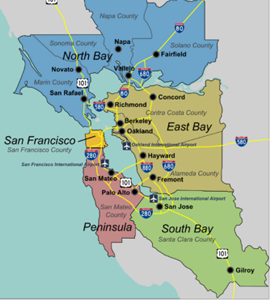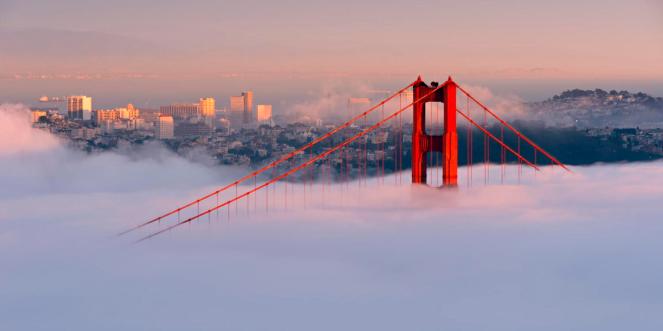Welcome to San Francisco! You’ll soon be part of a beautiful, dynamic city that has led the world in trailblazing the ways we live and work. Get ready to fall in love.
Unfortunately, a lot of other people are also falling in love with this city. That’s why San Francisco has the most expensive rental market in the country (the median one-bedroom was $3,670 in October 2015) and Oakland is catching up steadily at #4 (median one-bedroom $2,190 in November 2015). But sticker price shouldn’t be your only consideration. Here are a few things unique to the Bay Area to consider:
Geography
The Bay Area ecosystem spans so much more than San Francisco. You can plan hundreds of different weekend road trips within a two hour drive, whether it’s to wineries or beaches or scenic hikes. Here’s what you need to know:

San Francisco. A city and county in itself, it sits at the end of a peninsula. The city is 7 miles x 7 miles for a total of 49 square miles and holds a population of 800,000. Once a conservative Irish Catholic town, it became the stage for waves of progressive reforms that shook the country, many of them beautifully captured in the colorful book Season of the Witch: Enchantment, Terror, and Deliverance in the City of Love. Today it leads the country in technological prowess and socially conscious innovation.
North Bay. Drive north across the Golden Gate Bridge and you’ll find yourself in North Bay, which encompasses Marin, Napa, Solano, and Sonoma counties. While this area is famous for its wineries, don’t miss the fantastic fresh oysters, redwood forests, sustainable dairy farms, and beautiful hills. This is the least urbanized part of the Bay Area.
East Bay. The most populous sub-region, East Bay lies on the other side of the 4-mile long Bay Bridge and has a population of more than 2 million. It includes Alameda and Contra Costa counties and cities like Oakland and Berkeley. Oakland in particular is one of the most ethnically diverse cities in the country and gentrifying rapidly. Many families live out in East Bay.
South Bay. This area south of San Francisco includes San Jose and the general area known as Silicon Valley. Many notable tech companies are headquartered here. South Bay also has some of the most remarkable scenic drives and hiking trails in the Bay Area. The northwest portion of South Bay (Palo Alto, Mountain View, Los Altos and Los Altos Hills) is often called the Peninsula.
Microclimates and Karl the Fog. If you hear people talk about Karl, they’re referring to the ubiquitous clouds that often shroud the city proper (and nowhere else). He’ll often roll in from the ocean around sunset like a blanket tucking the city to sleep.
Some areas of the city are much sunnier than others. You can take a ten minute drive through five neighborhoods and see a roasting blue sky, dense fog, and freezing rain. Combined with the 50-70 degree weather year round, we recommend several thin layers on your person at all times, which is one handy use of your obligatory backpack as a fashionable San Franciscan. Always be prepared.

San Francisco Neighborhoods
Rather than recreate the wheel, here are some great guides on San Francisco neighborhoods:
- A great, frank writeup on the personality of each neighborhood by SanFrancisco.com.
- A sardonic, funny rundown of neighborhoods on The Bold Italic.
- Airbnb’s neighborhood guide, which has maps, transit info, and great photos.
Rent Control and Evictions
Most buildings built before 1979 in San Francisco and 1983 in Oakland are rent controlled, meaning a landlord cannot raise rent more than a certain percentage each year as established by the city government (the rate changes each year). While sleek high rises might seem nice to some, you may want to make your nest in a loveable Victorian if escalating rent is a concern.
In fact, a large number of people stay in their apartments for decades because rent control protects them from a market that would have otherwise driven them out of the city. Many of my friends in their 30s have been in the same place for 7-10 years; my older neighbors have rented their current homes for 40+ years. That’s why I always recommend for people to invest in an apartment that they could see themselves living in for a long time, even if the search takes slightly longer.
SF and Oakland also have strong tenant protections (not surprising in the motherland of political activism). It is very difficult to get evicted in San Francisco. The San Francisco Tenants Union runs a donation-based drop-in counseling clinic, while the Oakland Tenants Union offers a support line and monthly meetings. Note that it is your responsibility as a tenant to know your rights regarding rent increases and evictions, and you have a limited time to contest it with the city if you discover a violation.
Cost of Transportation
Commute planning should not be taken lightly in finding a home. Even as the Bay Area public transportation grid is ominously limited, its traffic and parking availability can be just as bad.
Most public transportation companies (including BART, Muni, and Caltrain) take Clipper Card, a rechargeable card that you touch to the ticket pads to use. These babies cost $3 initially and can be auto-loaded every month, charged online, or charged at a machine in the station. Note that many companies, even small ones, will offer a tax-deductible or even free monthly Clipper Card as part of their benefits; make sure you check with your employer. Check out the Clipper Card website for more info, including a full list of transit providers that accept Clipper Card.
Here are some of the major transportation options:
Bay Area Rapid Transit (The BART). Combining the worst of a commuter rail and a subway, BART links East Bay with downtown San Francisco. You can also take it directly to SFO, especially when traffic is bad. Fares range by distance, and there is no monthly pass, meaning you could easily spend $200 a month on BART.
The Muni. The city of SF’s own transportation system includes subways, buses, streetcars, and cable cars. While the subway does not have wide coverage, it’s a fantastic fast option if you manage to live near a stop. Buses are generally slow enough that you can often walk the same distance in the same amount of time, but if you live near an express bus, these can be a great option. I don’t recommend the touristy streetcars or cable cars unless it’s late at night or they’re not crowded. There is a flat $2.25 per trip and a $70 monthly unlimited Muni pass.
Caltrain. Caltrain runs south from AT&T Ballpark to destinations in South Bay. Fares range by distance (calculated by 6 zones), and monthly passes range from $73 to $338.
Owning a car:
- Within SF. Driving in SF is expensive for many reasons. A monthly parking spot can run $300, and if you’re driving to a restaurant or a friend’s house, it’s common to circle for 30-45 minutes to find a street parking spot. There are few garages, and the city is in fact making an effort to reduce the number of street parking spots to discourage car ownership. Traffic inches to a stop during rush hour, and many people who own cars still take an alternate method to work.
- From East Bay or North Bay into SF. There are tolls on the Bay Bridge and Golden Gate Bridge. The Bay Bridge in particular is famous for horrible traffic jams. There are no tunnels or alternate routes for cars.
- From SF towards South Bay. While the two major roads, the 101 and 280, do not have tolls, they see significant traffic in the mornings. My friends who work in Silicon Valley generally set their hours significantly before or after the thickest hours to avoid the traffic, which can turn a 45 minute drive into a 2 hour drive. Others take shuttles or Caltrain.
Ridesharing. Services like Lyft and Uber were founded in SF for a good reason: it’s needed here. Especially within SF, they often have a ceiling on their rates and offer great deals. While most people still use ridesharing for errands or nights out, the companies are making an ambitious push into commuting as well. If you don’t yet have Lyft, click here for up to $50 in free credit. If you don’t yet have Uber, click here for a free ride up to $15.
Motorcycles and scooters. You’ll see a lot of these in SF. They’re much easier to park, they can weave between traffic, and let’s face it, they’re kind of cool. These are a great option if you live in a neighborhood without good public transit.
Bicycles. The San Francisco Bicycle Coalition has made great strides in getting dedicated bike lines and shared lanes installed through their advocacy, and they have a great map for cyclists that tell you where the worst of our famous hills are. However, bike theft is rampant in every part of the city; the chances of getting your bike stolen downtown are almost definite. As a rule, I will generally not ride anywhere I can’t bring my bike inside with me. Check out the SF Bicycle Coalition website for more resources.
Walking. If you work downtown, there are a surprising number of neighborhoods where you could live and walk to work. Especially in places without good public transit, it can take just as long to ride a crowded bus as it does to have a nice morning stroll. Make sure you take the hills into account, but also know that by the end of your first few weeks, you’re not even going to notice it.
Other modes of transportation:
- If you live in North or East Bay, you may live near a commuter ferry.
- If you work for a Silicon Valley tech company, they may offer free commute shuttles throughout the city.
- For non-commutes, car-sharing rental services like Zipcar, Getaround, and Relay Rides are a great affordable way to have a day trip or weekend trip without the full cost of a car.
A full list of Bay Area transportation options can be found here.